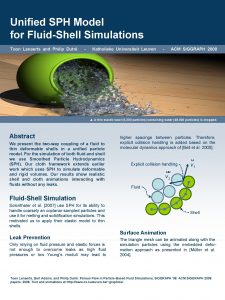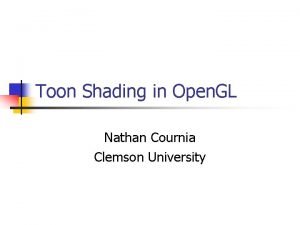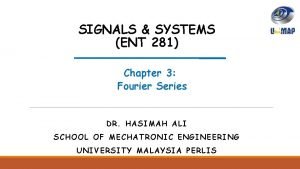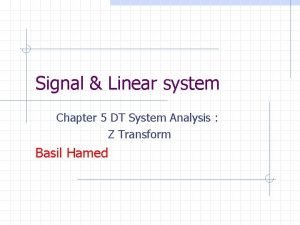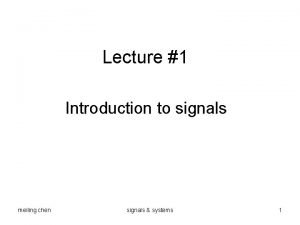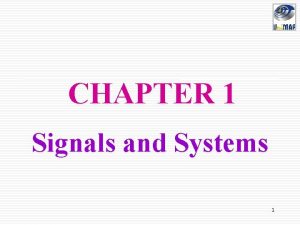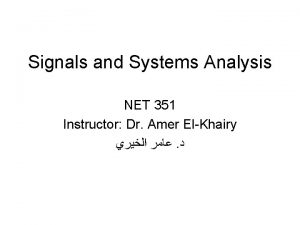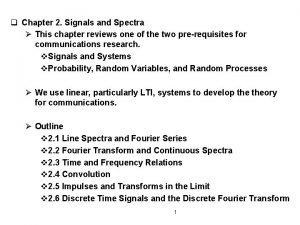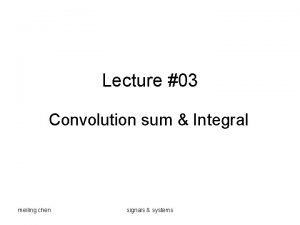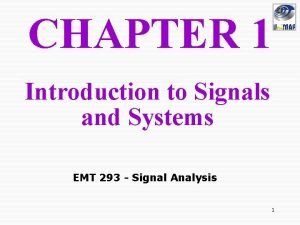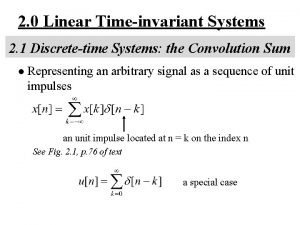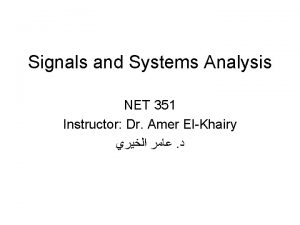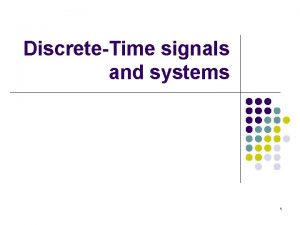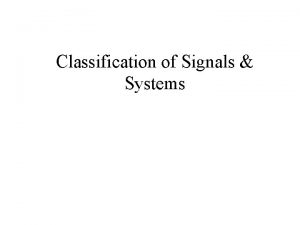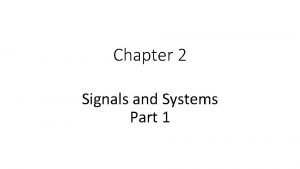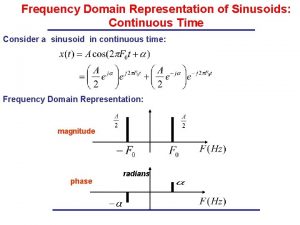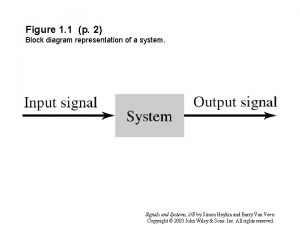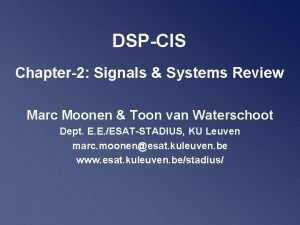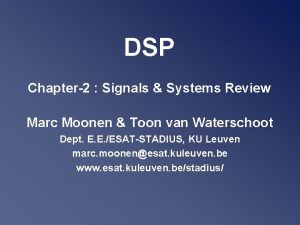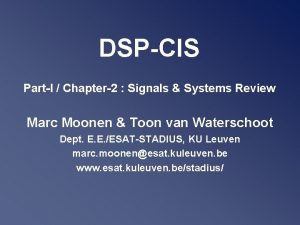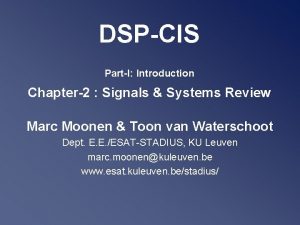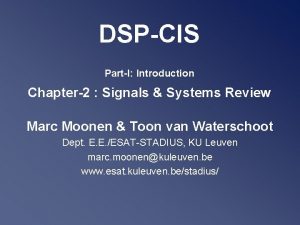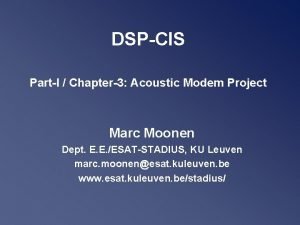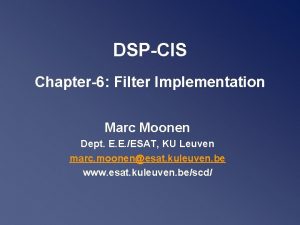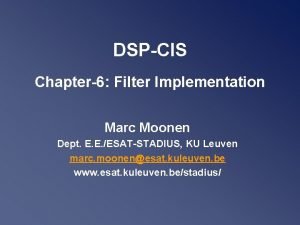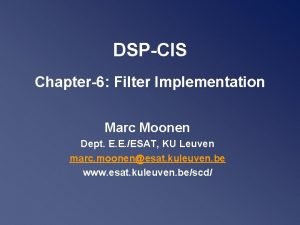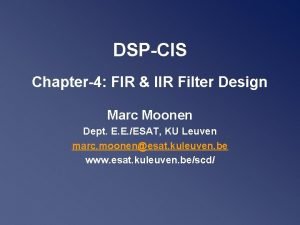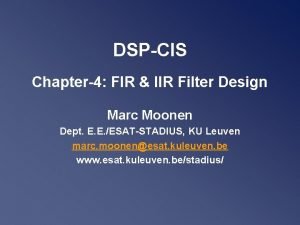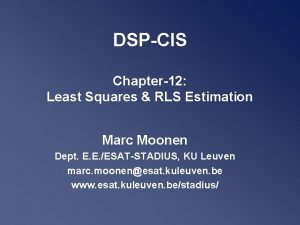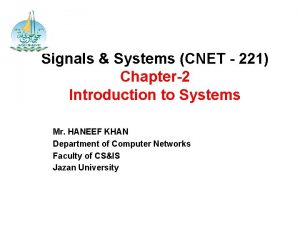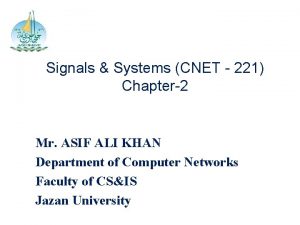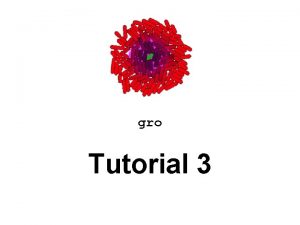DSPCIS Chapter2 Signals Systems Review Marc Moonen Toon












![Discrete-Time Systems 1/13 Discrete-time system is `sampled data’ system u[k] y[k] Input signal u[k] Discrete-Time Systems 1/13 Discrete-time system is `sampled data’ system u[k] y[k] Input signal u[k]](https://slidetodoc.com/presentation_image_h2/5f390f1027a7d19d745e2b33dcc8d48d/image-13.jpg)
![Discrete-Time Systems 2/13 Will consider linear time-invariant (LTI) systems u[k] y[k] Linear : input Discrete-Time Systems 2/13 Will consider linear time-invariant (LTI) systems u[k] y[k] Linear : input](https://slidetodoc.com/presentation_image_h2/5f390f1027a7d19d745e2b33dcc8d48d/image-14.jpg)
![Discrete-Time Systems 3/13 Will consider causal systems iff for all input signals with u[k]=0, Discrete-Time Systems 3/13 Will consider causal systems iff for all input signals with u[k]=0,](https://slidetodoc.com/presentation_image_h2/5f390f1027a7d19d745e2b33dcc8d48d/image-15.jpg)
![Discrete-Time Systems 4/13 Convolution u[0], u[1], u[2], u[3] y[0], y[1], . . . h[0], Discrete-Time Systems 4/13 Convolution u[0], u[1], u[2], u[3] y[0], y[1], . . . h[0],](https://slidetodoc.com/presentation_image_h2/5f390f1027a7d19d745e2b33dcc8d48d/image-16.jpg)
![Discrete-Time Systems 5/13 Z-Transform of system h[k] and signals u[k], y[k] Definition: Input/output relation: Discrete-Time Systems 5/13 Z-Transform of system h[k] and signals u[k], y[k] Definition: Input/output relation:](https://slidetodoc.com/presentation_image_h2/5f390f1027a7d19d745e2b33dcc8d48d/image-17.jpg)

![Discrete-Time Systems 7/13 Example-1 : `Delay operator’ K=0 u[k] y[k]=u[k-1] Impulse response is …, Discrete-Time Systems 7/13 Example-1 : `Delay operator’ K=0 u[k] y[k]=u[k-1] Impulse response is …,](https://slidetodoc.com/presentation_image_h2/5f390f1027a7d19d745e2b33dcc8d48d/image-19.jpg)










![Multi-Rate Systems 1/11 • Decimation : decimator (=downsampler) u[0], u[1], u[2]. . . D Multi-Rate Systems 1/11 • Decimation : decimator (=downsampler) u[0], u[1], u[2]. . . D](https://slidetodoc.com/presentation_image_h2/5f390f1027a7d19d745e2b33dcc8d48d/image-30.jpg)
![Multi-Rate Systems 2/11 • Z-transform & frequency domain analysis of expander u[0], u[1], u[2], Multi-Rate Systems 2/11 • Z-transform & frequency domain analysis of expander u[0], u[1], u[2],](https://slidetodoc.com/presentation_image_h2/5f390f1027a7d19d745e2b33dcc8d48d/image-31.jpg)
![Multi-Rate Systems 3/11 • Z-transform & frequency domain analysis of expander u[0], u[1], u[2], Multi-Rate Systems 3/11 • Z-transform & frequency domain analysis of expander u[0], u[1], u[2],](https://slidetodoc.com/presentation_image_h2/5f390f1027a7d19d745e2b33dcc8d48d/image-32.jpg)
![Multi-Rate Systems 4/11 • Z-transform & frequency domain analysis of decimator u[0], u[1], u[2]. Multi-Rate Systems 4/11 • Z-transform & frequency domain analysis of decimator u[0], u[1], u[2].](https://slidetodoc.com/presentation_image_h2/5f390f1027a7d19d745e2b33dcc8d48d/image-33.jpg)
![Multi-Rate Systems 5/11 • Z-transform & frequency domain analysis of decimator u[0], u[1], u[2]. Multi-Rate Systems 5/11 • Z-transform & frequency domain analysis of decimator u[0], u[1], u[2].](https://slidetodoc.com/presentation_image_h2/5f390f1027a7d19d745e2b33dcc8d48d/image-34.jpg)



![Multi-Rate Systems 9/11 • `Noble identities‘(only for rational functions) u[k] y[k] D u[k] D Multi-Rate Systems 9/11 • `Noble identities‘(only for rational functions) u[k] y[k] D u[k] D](https://slidetodoc.com/presentation_image_h2/5f390f1027a7d19d745e2b33dcc8d48d/image-38.jpg)


- Slides: 40

DSP-CIS Chapter-2 : Signals & Systems Review Marc Moonen & Toon van Waterschoot Dept. E. E. /ESAT-STADIUS, KU Leuven marc. moonen@kuleuven. be www. esat. kuleuven. be/stadius/

Chapter-2 : Signals & Systems Review • Discrete-Time/Digital Signals (10 slides) Sampling, quantization, reconstruction • Discrete-Time Systems (13 slides) LTI, impulse response, convolution, z-transform, frequency response, frequency spectrum, IIR/FIR • Discrete Fourier Transform (4 slides) DFT-IDFT, FFT • Multi-Rate Systems (11 slides) DSP-CIS 2018 / Chapter-2: Signals & Systems Review 2 / 40

1/10 Analog signal processing Analog domain (continuous-time domain) Analog IN Analog Signal Processing Circuit Jean-Baptiste Joseph Fourier (1768 -1830) Discrete-Time/Digital Signals Analog OUT (Fourier Transform / spectrum, where f = frequency) DSP-CIS 2018 / Chapter-2: Signals & Systems Review 3 / 40

Discrete-Time/Digital Signals 2/10 Digital signal processing Analog domain Analog IN Digital domain Analog-to. Digital Conversion 011010 0101 100110 0010 DSP Digital IN sampling & quantization DSP-CIS 2018 / Chapter-2: Signals & Systems Review Digital OUT Analog domain Digital-to. Analog Conversion Analog OUT reconstruction 4 / 40

Discrete-Time/Digital Signals 3/10 1. Sampling amplitude continuous-time signal discrete-time signal impulse train continuous-time (t) 01234 discrete-time [k] It will turn out (p. 24 -25) that a spectrum can be computed from x[k] (=discrete-time), which (remarkably) will be equal to the spectrum (=Fourier transform) of the (continuous-time) sequence of impulses…. . . DSP-CIS 2018 / Chapter-2: Signals & Systems Review 5 / 40

Discrete-Time/Digital Signals 4/10 So what does this spectrum of x. D(t) look like… • Spectrum replication – Time domain: – Frequency domain: magnitude frequency (f) DSP-CIS 2018 / Chapter-2: Signals & Systems Review magnitude frequency (f) 6 / 40

Discrete-Time/Digital Signals 5/10 • Sampling theorem – Analog signal spectrum X(f) runs up to fmax Hz – Spectrum replicas are separated by fs =1/Ts Hz magnitude frequency – No spectral overlap if and only if DSP-CIS 2018 / Chapter-2: Signals & Systems Review fs > 2. fmax 7 / 40

Discrete-Time/Digital Signals 6/10 • Sampling theorem – Analog signal spectrum X(f) runs up to fmax Hz – Spectrum replicas are separated by fs =1/Ts Hz magnitude frequency – Spectral overlap (=‘folding’, ‘aliasing’) if DSP-CIS 2018 / Chapter-2: Signals & Systems Review fs < 2. fmax 8 / 40

Discrete-Time/Digital Signals (*) Harry Nyquist (1889 – 1976) • Sampling theorem 7/10 – Terminology: • sampling frequency/rate fs • Nyquist frequency fs/2 • sampling interval/period Ts – E. g. CD audio: fs = 44, 1 k. Hz • Anti-aliasing prefilters – If then frequencies above the Nyquist frequency are ‘folded’ into lower frequencies (=aliasing) – To avoid aliasing, sampling is usually preceded by (analog-domain) low-pass (=anti-aliasing) filtering (*) An equivalent formulation is fs > fmax-(-fmax) = fmax-fmin = ‘bandwidth’…will use this in p. 36 DSP-CIS 2018 / Chapter-2: Signals & Systems Review 9 / 40

Discrete-Time/Digital Signals 2. B-bit quantization discrete-time signal amplitude 6 d. B per bit rule: 8/10 quantized discrete-time signal =discrete-amplitude&time signal =digital signal amplitude 3 Q 2 Q Q 0 -Q -2 Q -3 Q discrete time [k] R discrete time [k] Ex: CD audio = 16 bits ~ 96 d. B SNR (LP’s: 60 d. B SNR) DSP-CIS 2018 / Chapter-2: Signals & Systems Review 10 / 40

Discrete-Time/Digital Signals 9/10 3. Reconstruction – Reconstruction = ‘fill the gaps’ between adjacent samples – Example: staircase reconstructor amplitude discretetime/digital signal discrete time [k] reconstructed analog signal continuous time (t) – In a practical realization x. D(t) is generated first as an intermediate signal by means of a D-to-A & sampler, which is then followed by (analog domain) filtering (details omitted) DSP-CIS 2018 / Chapter-2: Signals & Systems Review 11 / 40

Discrete-Time/Digital Signals 10/10 • Complete scheme is… Analog IN rt… Analog OUT Digital IN DSP-CIS 2018 / Chapter-2: Signals & Systems Review is th er es Digital OUT nt reconstructor ri DSP ge quantizer lon No lon ge ri nt sampler No er es te te d d in in th is pa rt… antiimage postfilter pa antialiasing prefilter 12 / 40
![DiscreteTime Systems 113 Discretetime system is sampled data system uk yk Input signal uk Discrete-Time Systems 1/13 Discrete-time system is `sampled data’ system u[k] y[k] Input signal u[k]](https://slidetodoc.com/presentation_image_h2/5f390f1027a7d19d745e2b33dcc8d48d/image-13.jpg)
Discrete-Time Systems 1/13 Discrete-time system is `sampled data’ system u[k] y[k] Input signal u[k] is a sequence of samples (=numbers). . , u[-2], u[-1] , u[0], u[1], u[2], … System then produces a sequence of output samples y[k]. . , y[-2], y[-1] , y[0], y[1], y[2], … Example: `DSP’ block in previous slide DSP-CIS 2018 / Chapter-2: Signals & Systems Review 13 / 40
![DiscreteTime Systems 213 Will consider linear timeinvariant LTI systems uk yk Linear input Discrete-Time Systems 2/13 Will consider linear time-invariant (LTI) systems u[k] y[k] Linear : input](https://slidetodoc.com/presentation_image_h2/5f390f1027a7d19d745e2b33dcc8d48d/image-14.jpg)
Discrete-Time Systems 2/13 Will consider linear time-invariant (LTI) systems u[k] y[k] Linear : input u 1[k] -> output y 1[k] input u 2[k] -> output y 2[k] hence a. u 1[k]+b. u 2[k]-> a. y 1[k]+b. y 2[k] Time-invariant (shift-invariant) input u[k] -> output y[k] hence input u[k-T] -> output y[k-T] DSP-CIS 2018 / Chapter-2: Signals & Systems Review 14 / 40
![DiscreteTime Systems 313 Will consider causal systems iff for all input signals with uk0 Discrete-Time Systems 3/13 Will consider causal systems iff for all input signals with u[k]=0,](https://slidetodoc.com/presentation_image_h2/5f390f1027a7d19d745e2b33dcc8d48d/image-15.jpg)
Discrete-Time Systems 3/13 Will consider causal systems iff for all input signals with u[k]=0, k<0 -> output y[k]=0, k<0 K=0 input …, 0, 0, 1 , 0, 0, 0, . . . -> output …, 0, 0, h[0] , h[1], h[2], h[3], . . . General input u[0], u[1], u[2], u[3] (cfr. linearity & shift-invariance!) Otto Toeplitz (1881– 1940) Impulse response K=0 this is called a `Toeplitz’ matrix DSP-CIS 2018 / Chapter-2: Signals & Systems Review 15 / 40
![DiscreteTime Systems 413 Convolution u0 u1 u2 u3 y0 y1 h0 Discrete-Time Systems 4/13 Convolution u[0], u[1], u[2], u[3] y[0], y[1], . . . h[0],](https://slidetodoc.com/presentation_image_h2/5f390f1027a7d19d745e2b33dcc8d48d/image-16.jpg)
Discrete-Time Systems 4/13 Convolution u[0], u[1], u[2], u[3] y[0], y[1], . . . h[0], h[1], h[2], 0, 0, . . . = `convolution sum‘ (=more convenient than Toeplitz matrix notation when considering (infinitely) long input and impulse response sequences DSP-CIS 2018 / Chapter-2: Signals & Systems Review 16 / 40
![DiscreteTime Systems 513 ZTransform of system hk and signals uk yk Definition Inputoutput relation Discrete-Time Systems 5/13 Z-Transform of system h[k] and signals u[k], y[k] Definition: Input/output relation:](https://slidetodoc.com/presentation_image_h2/5f390f1027a7d19d745e2b33dcc8d48d/image-17.jpg)
Discrete-Time Systems 5/13 Z-Transform of system h[k] and signals u[k], y[k] Definition: Input/output relation: H(z) is `transfer function’ DSP-CIS 2018 / Chapter-2: Signals & Systems Review 17 / 40

Discrete-Time Systems 6/13 Z-Transform • Easy input-output relation: • May be viewed as `shorthand’ notation (for convolution operation/Toeplitz-vector product) • Stability =bounded input u[k] leads to bounded output y[k] --iff all the poles of H(z) lie inside the unit circle (now z=complex variable) (for causal, rational systems, see below) DSP-CIS 2018 / Chapter-2: Signals & Systems Review 18 / 40
![DiscreteTime Systems 713 Example1 Delay operator K0 uk ykuk1 Impulse response is Discrete-Time Systems 7/13 Example-1 : `Delay operator’ K=0 u[k] y[k]=u[k-1] Impulse response is …,](https://slidetodoc.com/presentation_image_h2/5f390f1027a7d19d745e2b33dcc8d48d/image-19.jpg)
Discrete-Time Systems 7/13 Example-1 : `Delay operator’ K=0 u[k] y[k]=u[k-1] Impulse response is …, 0, 0, 0 , 1, 0, 0, 0, … Transfer function is Pole at z=0 Example-2 : Delay + feedback K=0 Impulse response is …, 0, 0, 0 , 1, a, a^2, a^3… Transfer function is Pole at z=a u[k] y[k] + x a =simple rational function realized with a delay element, a multiplier and an adder DSP-CIS 2018 / Chapter-2: Signals & Systems Review 19 / 40

Discrete-Time Systems 8/13 Will consider only rational transfer functions: • L poles (zeros of A(z)) , L zeros (zeros of B(z)) • Corresponds to difference equation • Hence rational H(z) can be realized with finite number of delay elements, multipliers and adders • In general, this is a `infinitely long impulse response’ (`IIR’) system (as in example-2) DSP-CIS 2018 / Chapter-2: Signals & Systems Review 20 / 40

Discrete-Time Systems 9/13 Special case is • L poles at the origin z=0 (hence guaranteed stability) • L zeros (zeros of B(z)) = `all zero’ filter • Corresponds to difference equation =`moving average’ (MA) filter • Impulse response h[k] is = `finite impulse response’ (`FIR’) filter DSP-CIS 2018 / Chapter-2: Signals & Systems Review 21 / 40

Discrete-Time Systems 10/13 H(z) & frequency response: • Given a system H(z) • Given an input signal = complex exponential Im u[2] u[1] Re u[0]=1 • Output signal : (where ω=radial frequency) = `frequency response’ = complex function of radial frequency ω = H(z) evaluated on the unit circle DSP-CIS 2018 / Chapter-2: Signals & Systems Review 22 / 40

Discrete-Time Systems 11/13 H(z) & frequency response: • Periodic with period = • For a real-valued impulse response h[k] - magnitude response is even function - phase response is odd function • Example-1: Low-pass filter Nyquist frequency (=2 samples/period) • Example-2: All-pass filter DSP-CIS 2018 / Chapter-2: Signals & Systems Review DC 23 / 40

Discrete-Time Systems 12/13 • Z-Transform & Discrete-Time Fourier Transform – is frequency response of the LTI system – is frequency spectrum (‘Discrete-Time Fourier Transform’) of input signal (compare to Fourier Transform, see p. 3) – is frequency spectrum of the output signal DSP-CIS 2018 / Chapter-2: Signals & Systems Review 24 / 40

Discrete-Time Systems 13/13 • Z-Transform & Fourier Transform It is proved that… – The frequency response of an LTI system is equal to the Fourier transform of the continuous-time impulse sequence (see p. 5) constructed with h[k] – The frequency spectrum of a discrete-time signal is equal to the Fourier transform of the continuous-time impulse sequence constructed with u[k] or y[k] – iff DSP-CIS 2018 / Chapter-2: Signals & Systems Review corresponds to continuous-time are bandlimited ( no aliasing) 25 / 40

Discrete/Fast Fourier Transform 1/4 • DFT definition: – The `Discrete-time Fourier Transform’ of a discrete-time system/signal x[k] is a (periodic) continuous function of the radial frequency ω (see p. 28) – The `Discrete Fourier Transform’ (DFT) is a discretized version of this, obtained by sampling ω at N uniformly spaced frequencies (n=0, 1, . . , N-1) and by truncating x[k] to N samples (k=0, 1, . . , N-1) DSP-CIS 2018 / Chapter-2: Signals & Systems Review 26 / 40

Discrete/Fast Fourier Transform 2/4 • DFT & Inverse DFT (IDFT): – An N-point DFT sequence can be calculated from an N-point time sequence: = DFT – Conversely, an N-point time sequence can be calculated from an N-point DFT sequence: = IDFT DSP-CIS 2018 / Chapter-2: Signals & Systems Review 27 / 40

Discrete/Fast Fourier Transform 3/4 • DFT/IDFT in matrix form – Using shorthand notation. . –. . the DFT can be rewritten as –. . the IDFT can be rewritten as DSP-CIS 2018 / Chapter-2: Signals & Systems Review 28 / 40

Discrete/Fast Fourier Transform 4/4 • Fast Fourier Transform (FFT) (1805/1965) Split up N-point DFT in two N/2 -point DFT’s Split up two N/2 -point DFT’s in four N/4 -point DFT’s … Split up N/2 2 -point DFT’s in N 1 -point DFT’s Calculate N 1 -point DFT’s Rebuild N/2 2 -point DFT’s from N 1 -point DFT’s … Rebuild two N/2 -point DFT’s from four N/4 -point DFT’s Rebuild N-point DFT from two N/2 -point DFT’s – DFT complexity of N 2 multiplications is reduced to FFT complexity of O(N. log 2(N)) multiplications James W. Cooley • • • John W. Tukey Carl Friedrich Gauss (1777 -1855) – Divide-and-conquer approach: – Similar IFFT DSP-CIS 2018 / Chapter-2: Signals & Systems Review 29 / 40
![MultiRate Systems 111 Decimation decimator downsampler u0 u1 u2 D Multi-Rate Systems 1/11 • Decimation : decimator (=downsampler) u[0], u[1], u[2]. . . D](https://slidetodoc.com/presentation_image_h2/5f390f1027a7d19d745e2b33dcc8d48d/image-30.jpg)
Multi-Rate Systems 1/11 • Decimation : decimator (=downsampler) u[0], u[1], u[2]. . . D u[0], u[D], u[2 D]. . . Example : u[k]: 1, 2, 3, 4, 5, 6, 7, 8, 9, … 2 -fold downsampling: 1, 3, 5, 7, 9, . . . • Interpolation : expander (=upsampler) u[0], u[1], u[2], . . . D u[0], 0, . . 0, u[1], 0, …, 0, u[2]. . . Example : u[k]: 1, 2, 3, 4, 5, 6, 7, 8, 9, … 2 -fold upsampling: 1, 0, 2, 0, 3, 0, 4, 0, 5, 0. . . DSP-CIS 2018 / Chapter-2: Signals & Systems Review 30 / 40
![MultiRate Systems 211 Ztransform frequency domain analysis of expander u0 u1 u2 Multi-Rate Systems 2/11 • Z-transform & frequency domain analysis of expander u[0], u[1], u[2],](https://slidetodoc.com/presentation_image_h2/5f390f1027a7d19d745e2b33dcc8d48d/image-31.jpg)
Multi-Rate Systems 2/11 • Z-transform & frequency domain analysis of expander u[0], u[1], u[2], . . . D u[0], 0, . . 0, u[1], 0, …, 0, u[2]. . . D `images’ 3 `Expansion in time domain ~ compression in frequency domain’ DSP-CIS 2018 / Chapter-2: Signals & Systems Review 31 / 40
![MultiRate Systems 311 Ztransform frequency domain analysis of expander u0 u1 u2 Multi-Rate Systems 3/11 • Z-transform & frequency domain analysis of expander u[0], u[1], u[2],](https://slidetodoc.com/presentation_image_h2/5f390f1027a7d19d745e2b33dcc8d48d/image-32.jpg)
Multi-Rate Systems 3/11 • Z-transform & frequency domain analysis of expander u[0], u[1], u[2], . . . D u[0], 0, . . 0, u[1], 0, …, 0, u[2]. . . Expander mostly followed by `interpolation filter’ to remove images (and `interpolate the zeros’) `images’ 3 LP Interpolation filter can be low-/band-/high-pass (see p. 35 -36 and Chapter-10) DSP-CIS 2018 / Chapter-2: Signals & Systems Review 32 / 40
![MultiRate Systems 411 Ztransform frequency domain analysis of decimator u0 u1 u2 Multi-Rate Systems 4/11 • Z-transform & frequency domain analysis of decimator u[0], u[1], u[2].](https://slidetodoc.com/presentation_image_h2/5f390f1027a7d19d745e2b33dcc8d48d/image-33.jpg)
Multi-Rate Systems 4/11 • Z-transform & frequency domain analysis of decimator u[0], u[1], u[2]. . . D u[0], u[D], u[2 D]. . . D d=2 d=0 d=1 3 `Compression in time domain ~ expansion in frequency domain’ PS: Note that is periodic with period while is periodic with period The summation with d=0…D-1 restores the periodicity with period ! DSP-CIS 2018 / Chapter-2: Signals & Systems Review 33 / 40
![MultiRate Systems 511 Ztransform frequency domain analysis of decimator u0 u1 u2 Multi-Rate Systems 5/11 • Z-transform & frequency domain analysis of decimator u[0], u[1], u[2].](https://slidetodoc.com/presentation_image_h2/5f390f1027a7d19d745e2b33dcc8d48d/image-34.jpg)
Multi-Rate Systems 5/11 • Z-transform & frequency domain analysis of decimator u[0], u[1], u[2]. . . D u[0], u[D], u[2 D]. . . Decimation introduces ALIASING if input signal occupies frequency band larger than , hence mostly preceded by anti-aliasing (decimation) filter d=2 LP d=0 d=1 3 Anti-aliasing filter can be low-/band-/high-pass (see p. 35 -36 and Chapter-10) DSP-CIS 2018 / Chapter-2: Signals & Systems Review 34 / 40

Multi-Rate Systems 6/11 • Example: LP anti-aliasing / down / up / LP interpolation fmax LP (*) 3 3 LP Will be used in Part IV on ‘Filterbanks’ DSP-CIS 2018 / Chapter-2: Signals & theorem: Systems Review (*) Corresponds to Nyquist 3 -fold reduction fmax 3 -fold reduction fs 35 / 40

Multi-Rate Systems 7/11 • Example: HP anti-aliasing / down / up / HP interpolation fmin fmax HP (*) 3 3 HP Will be used in Part IV on ‘Filterbanks’ DSP-CIS 2018 / Chapter-2: Signals & Systems Review signals: fs > fmax-fmin (as in footnote p. 9, now fmin ≠ 36 / 40 ) (*) Corresponds to Nyquist theorem for ‘passband’ -fmax

Multi-Rate Systems 8/10 • Interconnection of multi-rate building blocks D x D = x a u 1[k] a D + = u 2[k] u 1[k] D x = u 2[k] u 1[k] D u 2[k] D + x i. e. all filter operations can be performed at the lowest rate! Identities also hold if decimators are replaced by expanders DSP-CIS 2018 / Chapter-2: Signals & Systems Review 37 / 40
![MultiRate Systems 911 Noble identitiesonly for rational functions uk yk D uk D Multi-Rate Systems 9/11 • `Noble identities‘(only for rational functions) u[k] y[k] D u[k] D](https://slidetodoc.com/presentation_image_h2/5f390f1027a7d19d745e2b33dcc8d48d/image-38.jpg)
Multi-Rate Systems 9/11 • `Noble identities‘(only for rational functions) u[k] y[k] D u[k] D = y[k] D DSP-CIS 2018 / Chapter-2: Signals & Systems Review y[k] u[k] = y[k] D 38 / 40

Multi-Rate Systems 10/10 Application of `noble identities : efficient multi-rate realizations of FIR filters through… • Polyphase decomposition: Example : (2 -fold decomposition) Example : (3 -fold decomposition) General: (D-fold decomposition) DSP-CIS 2018 / Chapter-2: Signals & Systems Review 39 / 40

Multi-Rate Systems 11/11 • Polyphase decomposition: Example : efficient realization of FIR decimation/interpolation filter u[k] H(z) + u[k] = 2 H(z) 2 u[k] + 2 = u[k] 2 2 + i. e. all filter operations can be performed at the lowest rate! DSP-CIS 2018 / Chapter-2: Signals & Systems Review 40 / 40
 Hanneke moonen
Hanneke moonen Sophie moonen
Sophie moonen Communicative signals and informative signals
Communicative signals and informative signals Arbitrariness in human language and animal language
Arbitrariness in human language and animal language Communicative signals and informative signals
Communicative signals and informative signals Sph toon
Sph toon Toon mortelmans
Toon mortelmans Citetation
Citetation Gedicht fiets toon hermans
Gedicht fiets toon hermans The toon company
The toon company Toon blast 6500
Toon blast 6500 Dr toon mortelmans
Dr toon mortelmans Vray toon shader maya
Vray toon shader maya Ger construction
Ger construction Toon calders
Toon calders Toon koppelaars
Toon koppelaars Gl toon
Gl toon Pow toon 4 edu
Pow toon 4 edu Flanders hydraulics research
Flanders hydraulics research Eclat bart
Eclat bart Sin exponential form
Sin exponential form Signals and systems oppenheim solutions chapter 5
Signals and systems oppenheim solutions chapter 5 Shifting and scaling of signals
Shifting and scaling of signals Precedence rule in signals and systems
Precedence rule in signals and systems Convolution sum in signals and systems
Convolution sum in signals and systems Line spectrum in signals and systems
Line spectrum in signals and systems Convolution integrals
Convolution integrals Introduction to signals and systems
Introduction to signals and systems Convolution sum in signals and systems
Convolution sum in signals and systems Signals and systems
Signals and systems L
L Elementary signal
Elementary signal Signals and systems
Signals and systems Time frequency domain
Time frequency domain Signals and systems
Signals and systems Chapter review motion part a vocabulary review answer key
Chapter review motion part a vocabulary review answer key Ap gov final review
Ap gov final review Narrative review vs systematic review
Narrative review vs systematic review Systematic review definition
Systematic review definition Narrative review vs systematic review
Narrative review vs systematic review Unit 9 human body systems review
Unit 9 human body systems review





